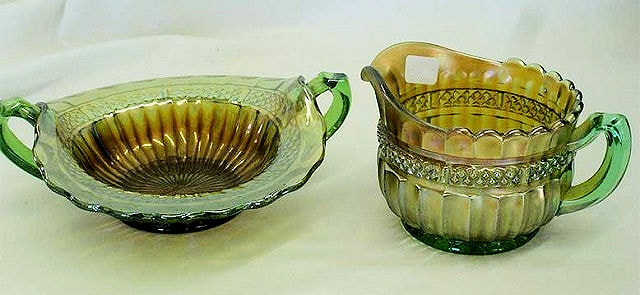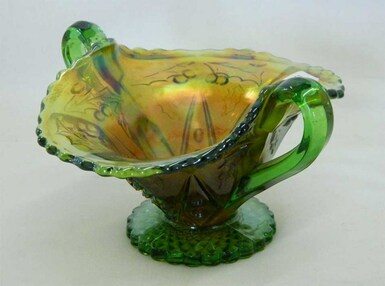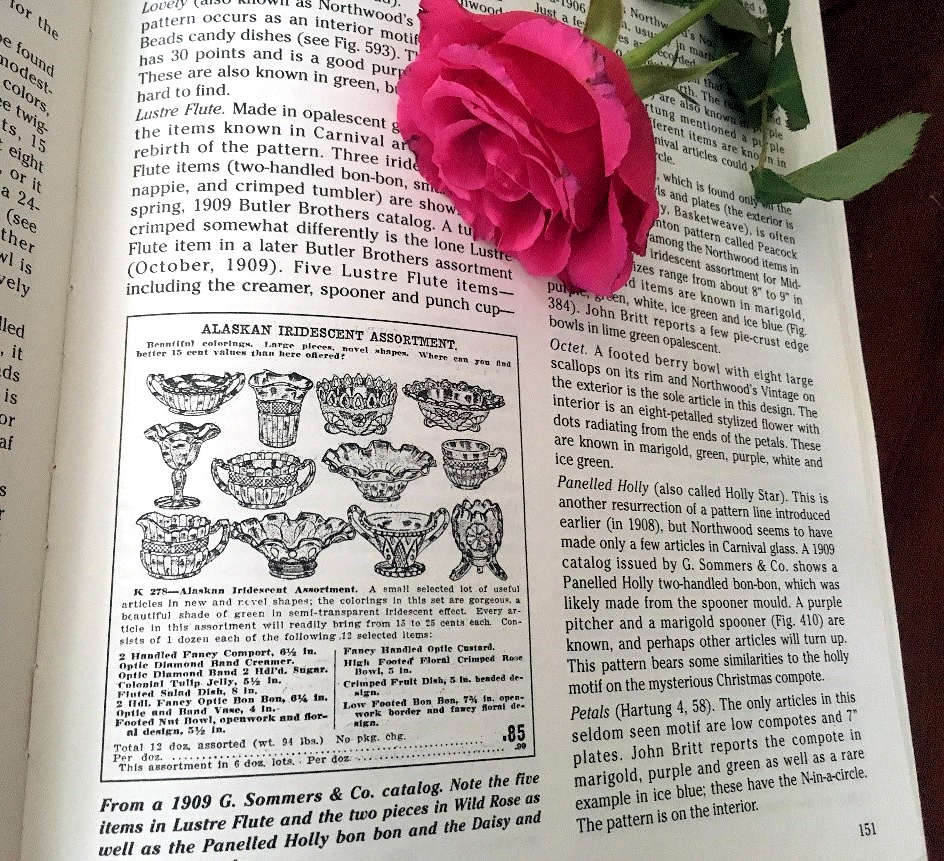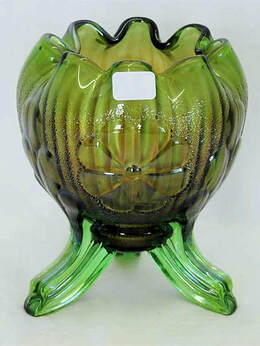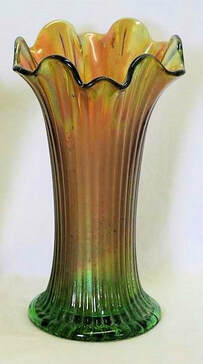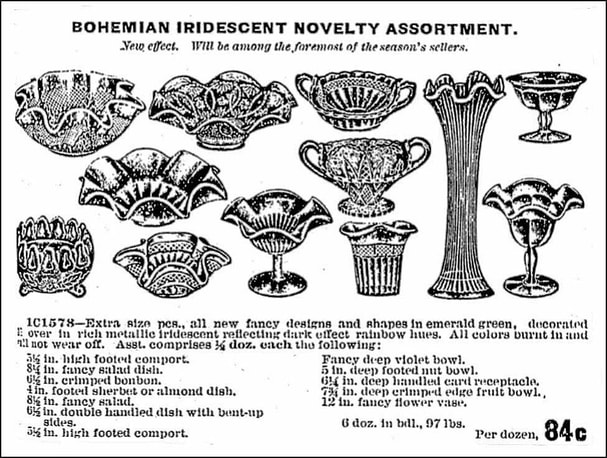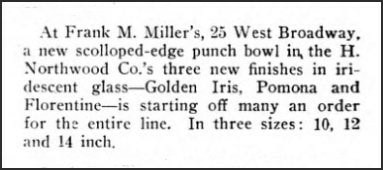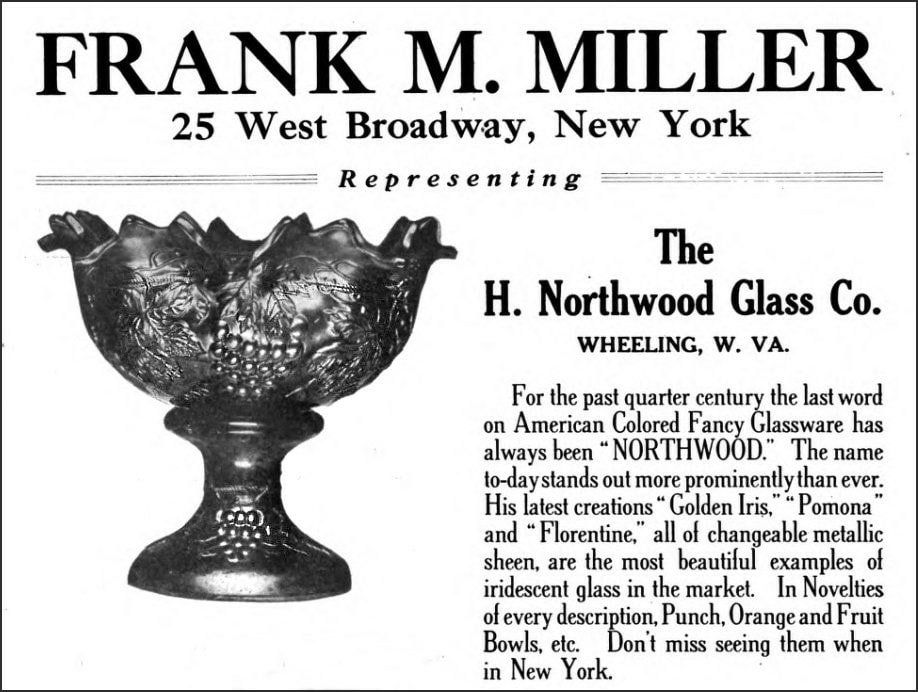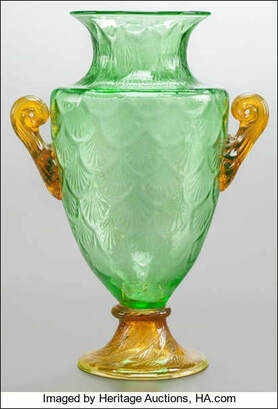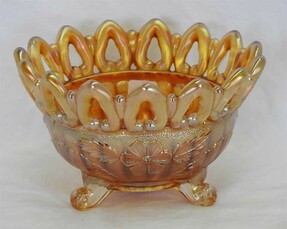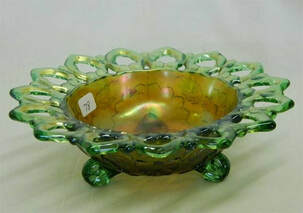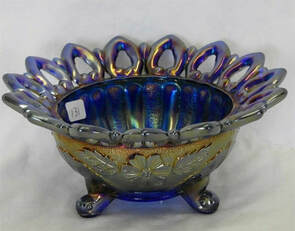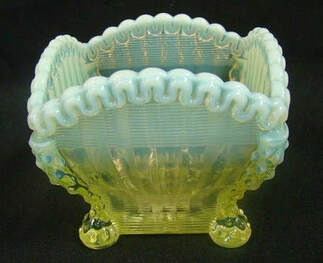The Great Alaskan Mystery
|
Many Carnival Glass collectors have heard the term “Alaskan” (or “Alaska”) or variations such as “Alaskan iridescence”, “Alaskan treatment”, “Alaskan green” or “Alaskan finish” – but what does it mean, what should it refer to, and how did it arise?
Let’s begin by considering what collectors usually mean when they use that term. Firstly, it's worth mentioning that it is a term that has only been in use with collectors since the 1990s. On the right is a handled bonbon and a creamer in Northwood’s Lustre Flute pattern. The base glass is green and the iridescence is the same type of ferric oxide spray that was used to give the orange colour to marigold Carnival. It imparts a golden, bronze/amber-like marigold iridescence to green based glass. This combination of green base glass and marigold iridescence – often with parts of the green glass showing through as they were (intentionally) not totally covered with the iridescent spray – is often termed “Alaskan” by Carnival collectors. |
Above: Northwood Lustre Flute – courtesy Seeck Auctions.
|
|
But what is the origin of the term, “Alaskan" as an iridescence / treatment / finish? It is a term that is specifically used in connection with Northwood Carnival Glass, and it first appears in the excellent book “Northwood The Wheeling Years” by Heacock, Measell and Wiggins (1991). On page 151 (shown on the right), there is an ad from a 1909 G. Sommers & Co. (Minnesota) wholesale catalogue. The glass shown is all Northwood’s and at the top of the ad it says “Alaskan Iridescent Assortment”. The items include Lustre Flute, Wild Rose, Panelled Holly and Daisy and Plume. |
For some considerable time, we have been trying to track down any other contemporaneous use of the term "Alaskan", but as far as we can ascertain this Sommers & Co. wholesale catalogue is the only source. In recent discussions (2019) in a Facebook group about this same topic, the highly respected Northwood researcher and author, Dr. James Measell stated that the term does not have a basis in Northwood’s history.
|
Our own research supports this: we cannot find any other source from that time to indicate that Harry Northwood specifically referred to his “Alaskan” treatment or effect, or that Northwood used the term himself. A wholesaler's promotion. We believe that "Alaskan" was a wholesaler’s promotional sales description – part of the general hype used to sell a glass assortment. The 1909 Sommers & Co. ad said the glass was "a beautiful shade of green in semi-transparent iridescent effect", which certainly sounds like the effect that has been labelled "Alaskan" - although in reality, it’s not possible to know for sure. There is no other indication in the (black and white, artist-drawn ad), and to date, we have not found any other ad, wholesale or retail, that used the term "Alaskan". In fact, is the description used by Sommers & Co. – "Alaskan Iridescent Assortment" – any different than all the other promotional names for the glass assortments that were given in Butler Brothers, Rouss, Sears and other wholesalers’ catalogues at the time? In fact, a very similar Northwood assortment of green Carnival Glass was featured in Butler Brothers catalogue at the same time (1909) where it was called “Bohemian Iridescent Assortment” (as shown below). |
Left: Daisy and Plume rosebowl and right, Northwood's Fine Rib vase.
Courtesy Seeck Auctions. |
This would suggest that if "Alaskan" had a claim to be an original term used to describe the bronze/amber/marigold effect on green glass, then "Bohemian" could have a similar claim! In reality, all kinds of promotional names were used by the wholesalers to describe their iridescent assortments – all designed to attract the customer and make them spend, spend, spend. Here are just a few from 1909 and 1910: Golden Sunset Iridescent Assortment, Bohemian Iridescent Novelty Assortment, Pompeiian Iridescent Assortment, Regal Metallic, Exposition Metallic Assortment, Parisian Art Assortment and Venetian Art Assortment. An earlier 1908 assortment (not iridescent) was even called “Klondyke Gold”.
Above: an extract from the 1909 Butler Brothers Catalogue.
The patterns and shapes were similar to the ones shown in the 1909 Sommers & Co. catalogue, and the glass was also described as green.
Lustre Flute, Panelled Holly, Wild Rose and the Fine Rib vase are all easily identified.
The patterns and shapes were similar to the ones shown in the 1909 Sommers & Co. catalogue, and the glass was also described as green.
Lustre Flute, Panelled Holly, Wild Rose and the Fine Rib vase are all easily identified.
|
If Harry Northwood did not use the term "Alaskan", what did he call this effect? In fact, Northwood had some specific terms of his own, for his “new” iridescent glass that was being introduced at this time. “Golden Iris”, “Pomona” and “Florentine” were the names used in ads by Harry Northwood’s agent, Frank Miller, specifically for Northwood’s iridescent glass. These terms were also written about in the February 1910 “Pottery, Glass and Brass” Journal, where they were described as “new finishes in iridescent glass” (in other words, the effects created by the iridescence on the glass) - see below. |
February 1910 “Pottery, Glass and Brass” Journal.
|
What did those “three new finishes” look like?
|
Golden Iris was undoubtedly marigold, and it’s interesting to note that Northwood was using a similar term to that which the Stourbridge glass firm of Thomas Webb had used for their earlier marigold iridescent glass (Webb’s “Iris”). Florentine was very probably the dark and vibrant iridescence we are used to seeing on Northwood’s purple and blue base glass. But what was Pomona? Pomona infers an apple green (“pomme” is French for apple), and an interesting fact is that Pomona was the name of a line made by Steuben! It was green base glass with (mainly) amber/orange additions such as handles (which were NOT iridised), that were applied to the glass body. See the example on the left. As everyone knows, the Carnival Glass producers were in the business of making affordable glassware that imitated the expensive Art Glass makers, such as Tiffany and Steuben. Indeed, Carnival Glass itself was said by many of its contemporaries to be “Poor Man’s Tiffany”. Harry Northwood was not averse to using, and indeed improving upon (as doubtless he saw it) some of the styles and techniques he learned in his formative years in the glass industry. For example, we know that the Northwood family were skilled at replacing art glass techniques with easy mass-production methods, such as threading (which was originally a manual operation), or replacing hand-applied features with ones produced in the mould (like the tornado motifs on Northwood's Tornado vases). We were struck by the similarity of Steuben's Pomona to the effect achieved by Northwood with his bronze/amber/marigold iridescence on green base glass, and how Northwood frequently applied the iridescent effect in a partial, selective manner. Could what we now call Northwood's "Alaska" treatment actually have been Northwood’s “Pomona” iridescent effect? Was it Harry’s way of effecting a classy, Steuben Art Glass “Pomona” look to his early Carnival? |
Shown below is Northwood’s Wild Rose pattern in what we believe are “the three new finishes in iridescent glass – ‘Golden Iris’, ‘Pomona’ and ‘Florentine’ “. All pictures, courtesy of Seeck Auctions.
|
Just to avoid confusion, it is worth saying that Northwood also issued a pattern in 1897-8 that was named “Alaska” (the original maker’s name) , which is also known as “Lion’s Leg”. This was made pre-Carnival and was never iridised. It is not connected in any way to the collector term, “Alaskan”, used in the context of an iridescent effect. Pictured on the right, a vaseline opal footed spooner in Northwood’s “Alaska” design. Courtesy Burns Auctions. |
